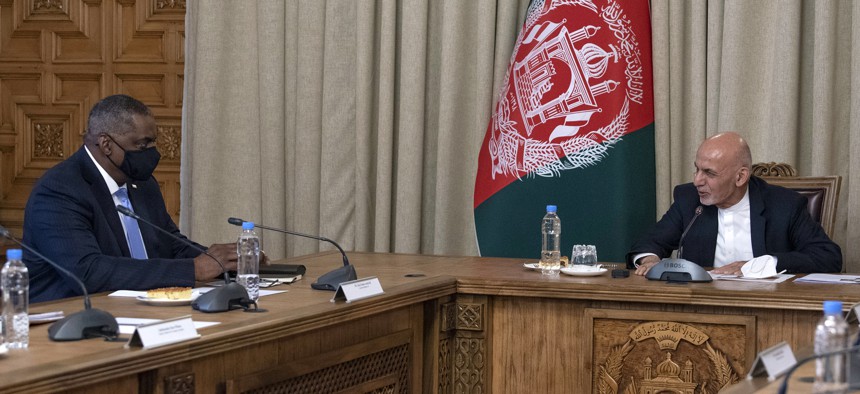
Defense Secretary Lloyd J. Austin meets with Afghan President Ashraf Ghani on March 21, 2021 in Kabul, Afghanistan. Lisa Ferdinando/DoD via Getty Images
Afghanistan Deadline is ‘Too Soon’ for Biden Administration, Top House Dem Says
‘Running for the exits pell-mell by May 1 is dangerous,’ said HASC Chairman Rep. Adam Smith, who backs pulling out ‘responsibly.’
There is a “general feeling” within the Biden administration that withdrawing all U.S. forces from Afghanistan by a May 1 deadline is “too soon,” largely due to the logistics of removing troops and equipment in such a short period of time, a top House Democrat said Wednesday.
“Running for the exits pell-mell by May 1 is dangerous,” Rep. Adam Smith, D-Wash., the chairman of the House Armed Services Committee, said during a virtual Foreign Policy event. “It is dangerous to our troops [and] I don't want to leave a bunch of, you know, high-grade military equipment behind for whoever grabs it either.”
Smith said that extending the U.S. and coalition presence in Afghanistan “is a purely logistical argument” and will not change the security situation in a country where more than 2,300 U.S. troops have been killed since 2001.
“I don't know what the future of Afghanistan is [and] I'm not terribly optimistic about it, but I don't think that lack of optimism changes if the U.S. stays for another year or another 10,” he said. “I think in that regard, we've learned the limits of what we can do there, and it is time to change our policy and pull out responsibly.”
Smith said that about 3,500 U.S. troops remain in Afghanistan, implicitly confirming a New York Times report that the Pentagon’s Jan. 15 tally — 2,500 troops — had left out another thousand U.S. special operators. That’s on top of some 7,500 troops from other members of the coalition.
“You cannot pull out 10,000 plus troops in any sort of reasonable way in six weeks,” Smith said. “So I think there's a general feeling that May 1 is too soon.”
The Trump administration committed last year to the May 1 withdrawal date during negotiations within the Taliban.
“Job one is to try to get back in and talk with the Taliban about at least giving us a little bit more time,” Smith said. “Now, the second piece of it is: as the Taliban gain influence…they have always had a very hard line: ‘all foreign troops out’ bottom line. And if that continues to be their position, I don't see where we have much choice.”
In Afghanistan on Sunday, Defense Secretary Lloyd Austin told reporters that U.S. officials were in the “process of reviewing” whether the Taliban has met the conditions it agreed to as part of the agreement for American forces to leave Afghanistan.
“There's a lot of energy focused on...doing what's necessary to bring about a responsible end — a negotiated settlement to the war,” Austin said.
Getting the troops themselves out of the landlocked nation is far less complicated than removing heavy armored vehicles, drones and other expensive military gear. Typically, the equipment is sent on convoys through Pakistan to Karachi where it is loaded on container ships for transport back to the U.S. That’s far cheaper than flying the equipment out on cargo planes.
In 2013, the U.S. destroyed about 20 percent of its armored vehicles and other equipment valued at $7 billion, according to The Washington Post, when it was trying to end the war by 2014.
